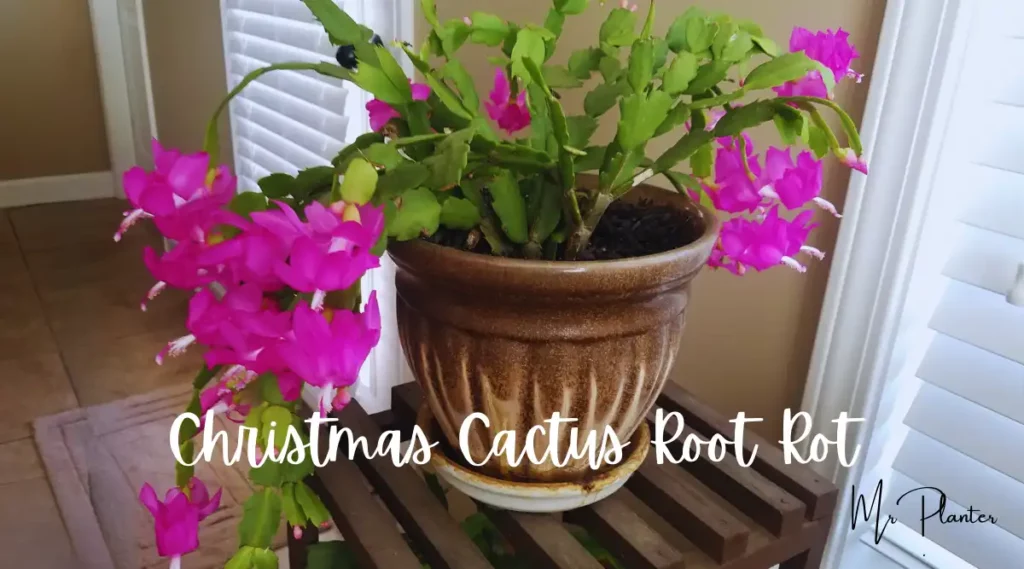Christmas cactus root rot is a fungal disease that affects the roots of Christmas cactus plants. It is a common problem among plant lovers and can cause significant damage to the plant if left untreated. Root rot is caused by overwatering, poor drainage, or a combination of both. When the soil becomes waterlogged, the roots stop getting oxygen, causing them to suffocate and die.
The first sign of root rot in a Christmas cactus is wilted, limp, and sagging growth. Upon inspection of the roots, you will notice blackened tips. Root rot can spread quickly, so it is important to address the problem as soon as possible. If left untreated, the plant can die.

There are several ways to treat Christmas cactus root rot, including propagating the plant, cutting off the affected roots, or repotting the plant in well-draining soil. Prevention is key when it comes to root rot, so it is important to ensure that the plant is not overwatered and has proper drainage.
In this article, we will discuss the causes, signs, and treatments of Christmas cactus root rot, as well as provide tips on how to prevent it from occurring in the first place.
Let’s get started!
What is Christmas Cactus Root Rot?
Christmas cactus root rot is a common problem that affects the popular holiday cactus plant. It is a fungal disease that attacks the roots of the plant and can quickly spread to the stem and leaves. Overwatering is the most common cause of root rot in Christmas cactus plants, but other factors like poor drainage, lack of sunlight, and low temperatures can also contribute to the development of this disease.
The early symptoms of Christmas cactus root rot are often subtle and easy to miss. The plant may appear wilted or droopy, even though it has been watered. The leaves may turn yellow or brown, and the stem may become soft or mushy to the touch. If left untreated, the disease can quickly spread throughout the plant, causing it to die.
To diagnose root rot in a Christmas cactus, gently remove the plant from its pot and inspect the roots. Healthy roots should be firm, white, and plump. If the roots are brown or black, mushy, or have a foul odor, they are likely infected with root rot.
Preventing Christmas cactus root rot is key to keeping your plant healthy. Be sure to plant your cactus in well-draining soil and avoid overwatering. Allow the soil to dry out between waterings and avoid leaving the plant in standing water. Additionally, make sure your cactus is getting enough sunlight and is not exposed to extreme temperatures.
Causes of Root Rot in Christmas Cactus
Root rot is a common problem that affects the flowering succulent Christmas cactus. It is important to understand the causes of root rot to prevent it from occurring in the first place. Here are some of the common causes:
- Overwatering: One of the most common causes of root rot is overwatering. Christmas cacti are native to the rainforests of Brazil, where they grow in well-draining soil. They are adapted to receive water in small amounts over a long period of time. When you overwater a Christmas cactus, the soil becomes saturated, and the roots cannot absorb oxygen, which leads to root rot.
- Wrong Soil Type: Christmas cacti require well-draining soil that is rich in organic matter. Using the wrong soil type can lead to root rot. Avoid using heavy, clayey soils that do not drain well. Instead, use a potting mix that is specifically designed for cacti and succulents.
- Pests: Pests such as mealybugs and spider mites can damage the roots of Christmas cacti, making them more susceptible to root rot. It is important to inspect your plants regularly and take action if you notice any signs of pest infestation.
It is important to note that root rot can also be caused by a combination of these factors. For example, overwatering combined with the wrong soil type can quickly lead to root rot.
To prevent root rot, it is important to provide your Christmas cactus with the right growing conditions. This includes using well-draining soil, watering your plant sparingly, and inspecting your plant regularly for signs of pest infestation.
Symptoms of Root Rot in Christmas Cactus
Root rot is a common problem that affects Christmas cactus plants. It is caused by a fungal infection that attacks the roots of the plant, causing them to rot and die. If left untreated, the plant will eventually die. Here are some of the symptoms of Christmas cactus root rot:
- Wilted leaves: One of the first signs of root rot is wilted leaves. The leaves will look wrinkled, limp, saggy, and wilted.
- Yellowing leaves: As the disease progresses, the leaves will turn yellow and fall off.
- Blackened roots: If you inspect the roots of the plant, you will notice that they are blackened and mushy. The roots may also have a foul odor.
- Stunted growth: The plant may stop growing or grow at a slower rate than normal.
It is important to catch root rot early before it spreads to other parts of the plant. If you notice any of these symptoms, it is important to take action immediately to save your Christmas cactus.
One way to prevent root rot is to make sure the plant is not overwatered. Overwatering can lead to waterlogged soil, which creates the perfect environment for fungal growth. Make sure the soil is well-draining and that the plant is not sitting in standing water.
If you suspect that your Christmas cactus has root rot, the first thing to do is to remove the plant from its pot and inspect the roots. If the roots are blackened and mushy, you will need to trim away the affected roots and repot the plant in fresh soil. Make sure to sterilize your pruning tools to prevent the spread of the disease.
Prevent Root of Christmas Cactus from Rotting
Preventing root rot in Christmas cacti is the best way to ensure the health and longevity of your plant. Here are some simple tips to prevent root rot:
- Use well-draining soil: Christmas cacti prefer soil that drains well. Avoid using heavy, clay soils or soils that retain too much moisture.
- Choose the right container: Make sure the container you use has drainage holes to allow excess water to escape. Avoid containers that are too large, as they can hold too much water and lead to root rot.
- Water sparingly: Overwatering is the main cause of root rot in Christmas cacti. Water your plant thoroughly, but only when the soil feels slightly dry. Avoid letting the potting mix become bone dry, as this can also damage the roots.
- Avoid cold drafts: Christmas cacti prefer warm, humid environments. Avoid placing your plant in areas with cold drafts or where temperatures fluctuate too much.
- Fertilize sparingly: Overfertilizing can also lead to root rot in Christmas cacti. Use a balanced, water-soluble fertilizer sparingly, and only during the growing season.
By following these simple tips, you can prevent root rot in your Christmas cactus and enjoy a healthy, vibrant plant for years to come.
Fix Root Rotting Issue for Christmas Cactus
Root rot is a common problem with Christmas cactus, but it can be treated. The first step is to identify the problem early and take action. Here are some effective treatments for Christmas cactus root rot:
- Stop watering: If you notice root rot in your Christmas cactus, stop watering it immediately. Overwatering is the most common cause of root rot, and continuing to water the plant will only make the problem worse.
- Remove the plant from the soil: Carefully remove the plant from the soil and gently shake off any excess soil. Inspect the roots and remove any that are brown, mushy, or slimy. These roots are dead and cannot be saved.
- Cut away affected areas: Use a clean, sharp knife to cut away any affected areas of the stem or roots. Be sure to cut at least 1 inch above and below the affected area to ensure that all of the infected tissue is removed.
- Let the plant dry out: After removing the affected areas, let the plant dry out for a few days. This will help to prevent further spread of the disease.
- Repot the plant: Once the plant has dried out, repot it in fresh, well-draining soil. Be sure to use a pot with drainage holes to prevent overwatering.
- Water sparingly: After repotting, water the plant sparingly. Allow the soil to dry out completely between waterings to prevent overwatering and root rot.
Remember, prevention is always better than cure. To prevent root rot in your Christmas cactus, be sure to use well-draining soil, water sparingly, and avoid overwatering. With proper care, your Christmas cactus can thrive and bloom for many years to come.
Conclusion
Root rot is a common problem that affects Christmas cacti. Overwatering is the primary cause of root rot in these plants. It is crucial to water Christmas cacti sparingly and only when the soil is dry to the touch. If you suspect that your Christmas cactus has root rot, you should act quickly to save it.
Pruning away the damaged roots, cutting back the leaves and branches, and repotting the plant in fresh soil are some of the steps you can take to treat root rot. However, prevention is always better than cure, and the best way to prevent root rot is to ensure that the plant is not overwatered.
If you notice any signs of root rot, such as yellowing or wilting leaves, or a foul smell emanating from the soil, you should take immediate action. With proper care and attention, your Christmas cactus can recover from root rot and continue to thrive.
Remember to always use well-draining soil, avoid over-fertilizing, and keep your Christmas cactus in a bright, indirect light. With these simple tips, you can enjoy a beautiful and healthy Christmas cactus for many years to come.

